University Assignment: Purpose and Principles of Independent Advocacy
VerifiedAdded on 2020/02/24
|15
|3307
|1271
Report
AI Summary
This report provides a comprehensive overview of independent advocacy, encompassing its purpose, core principles, and historical development. It defines independent advocacy, outlining its limits and boundaries, and details the steps within the advocacy process. The report distinguishes when independent advocacy can and cannot provide assistance, and identifies various services commonly signposted by independent advocates. It emphasizes the key principles underpinning independent advocacy, such as clarity of purpose, freedom, empowerment, and equal opportunity, and explains their importance. The report explores different types of advocacy support, including statutory, case, and citizen advocacy, and compares various advocacy models. It further examines the roles and responsibilities of an independent advocate, including their skills, attitudes, and the boundaries of their role, as well as the standards that apply to independent advocacy and their impact on the advocacy service. The report concludes by highlighting the milestones in the history of advocacy and its wider policy context.

Running head: PURPOSE AND PRINCIPLES OF INDEPENDT ADVOCACY
Purpose and Principles of Independent Advocacy
Name of the Student:
Name of the University:
Author Note
Purpose and Principles of Independent Advocacy
Name of the Student:
Name of the University:
Author Note
Paraphrase This Document
Need a fresh take? Get an instant paraphrase of this document with our AI Paraphraser
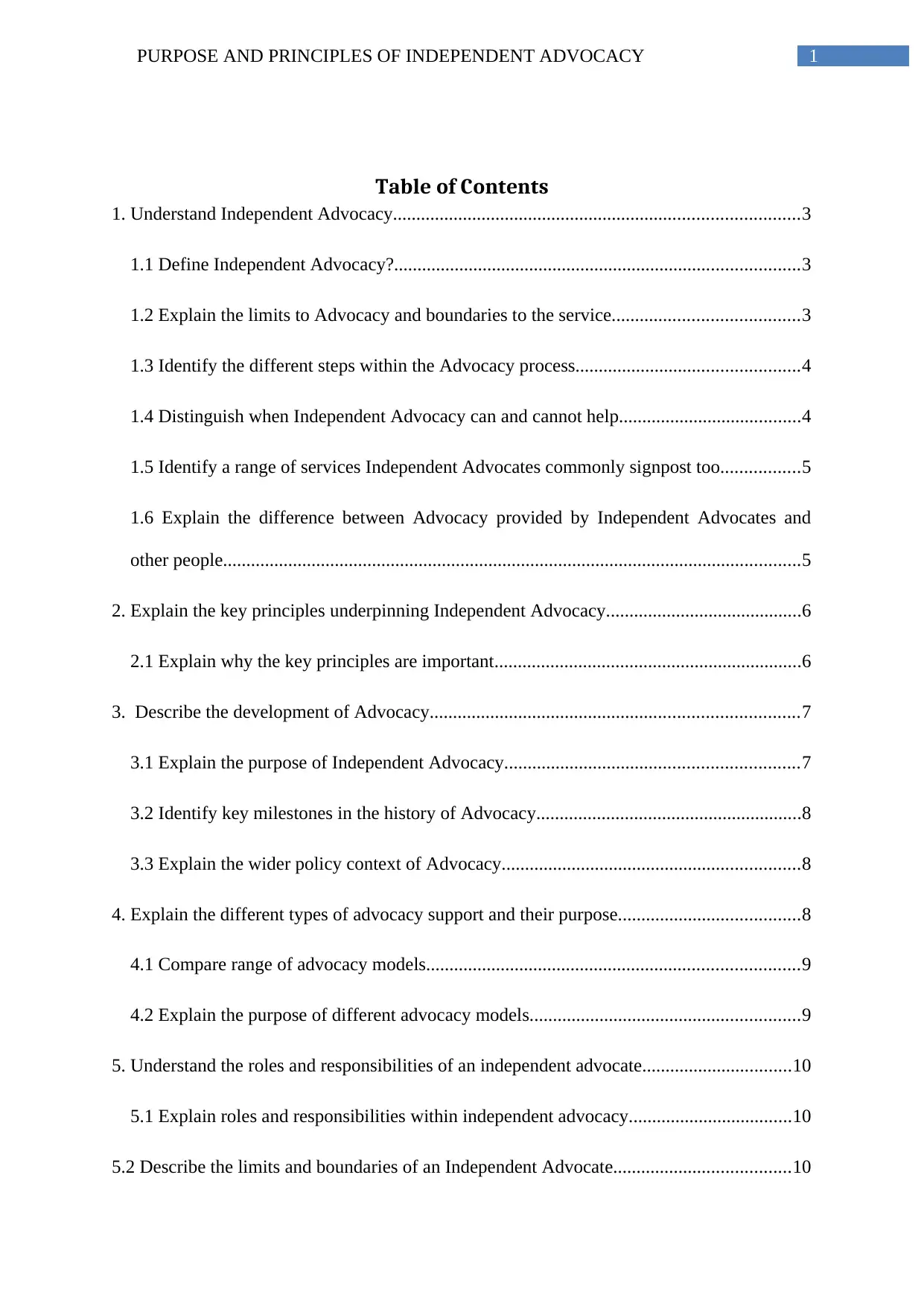
1PURPOSE AND PRINCIPLES OF INDEPENDENT ADVOCACY
Table of Contents
1. Understand Independent Advocacy.......................................................................................3
1.1 Define Independent Advocacy?.......................................................................................3
1.2 Explain the limits to Advocacy and boundaries to the service........................................3
1.3 Identify the different steps within the Advocacy process................................................4
1.4 Distinguish when Independent Advocacy can and cannot help.......................................4
1.5 Identify a range of services Independent Advocates commonly signpost too.................5
1.6 Explain the difference between Advocacy provided by Independent Advocates and
other people............................................................................................................................5
2. Explain the key principles underpinning Independent Advocacy..........................................6
2.1 Explain why the key principles are important..................................................................6
3. Describe the development of Advocacy...............................................................................7
3.1 Explain the purpose of Independent Advocacy...............................................................7
3.2 Identify key milestones in the history of Advocacy.........................................................8
3.3 Explain the wider policy context of Advocacy................................................................8
4. Explain the different types of advocacy support and their purpose.......................................8
4.1 Compare range of advocacy models................................................................................9
4.2 Explain the purpose of different advocacy models..........................................................9
5. Understand the roles and responsibilities of an independent advocate................................10
5.1 Explain roles and responsibilities within independent advocacy...................................10
5.2 Describe the limits and boundaries of an Independent Advocate......................................10
Table of Contents
1. Understand Independent Advocacy.......................................................................................3
1.1 Define Independent Advocacy?.......................................................................................3
1.2 Explain the limits to Advocacy and boundaries to the service........................................3
1.3 Identify the different steps within the Advocacy process................................................4
1.4 Distinguish when Independent Advocacy can and cannot help.......................................4
1.5 Identify a range of services Independent Advocates commonly signpost too.................5
1.6 Explain the difference between Advocacy provided by Independent Advocates and
other people............................................................................................................................5
2. Explain the key principles underpinning Independent Advocacy..........................................6
2.1 Explain why the key principles are important..................................................................6
3. Describe the development of Advocacy...............................................................................7
3.1 Explain the purpose of Independent Advocacy...............................................................7
3.2 Identify key milestones in the history of Advocacy.........................................................8
3.3 Explain the wider policy context of Advocacy................................................................8
4. Explain the different types of advocacy support and their purpose.......................................8
4.1 Compare range of advocacy models................................................................................9
4.2 Explain the purpose of different advocacy models..........................................................9
5. Understand the roles and responsibilities of an independent advocate................................10
5.1 Explain roles and responsibilities within independent advocacy...................................10
5.2 Describe the limits and boundaries of an Independent Advocate......................................10

2PURPOSE AND PRINCIPLES OF INDEPENDENT ADVOCACY
5.3 Describe the skills, attitude and personal attributes of a good advocate........................11
5.4 Identify when and who to seek advice from when faced with dilemmas......................11
6. Understand advocacy standards...........................................................................................11
6.1 Describe a range of standards which apply to independent advocacy...........................12
6.2 Explain how standards can impact on the advocacy role and service............................12
Reference List..........................................................................................................................13
5.3 Describe the skills, attitude and personal attributes of a good advocate........................11
5.4 Identify when and who to seek advice from when faced with dilemmas......................11
6. Understand advocacy standards...........................................................................................11
6.1 Describe a range of standards which apply to independent advocacy...........................12
6.2 Explain how standards can impact on the advocacy role and service............................12
Reference List..........................................................................................................................13
⊘ This is a preview!⊘
Do you want full access?
Subscribe today to unlock all pages.

Trusted by 1+ million students worldwide
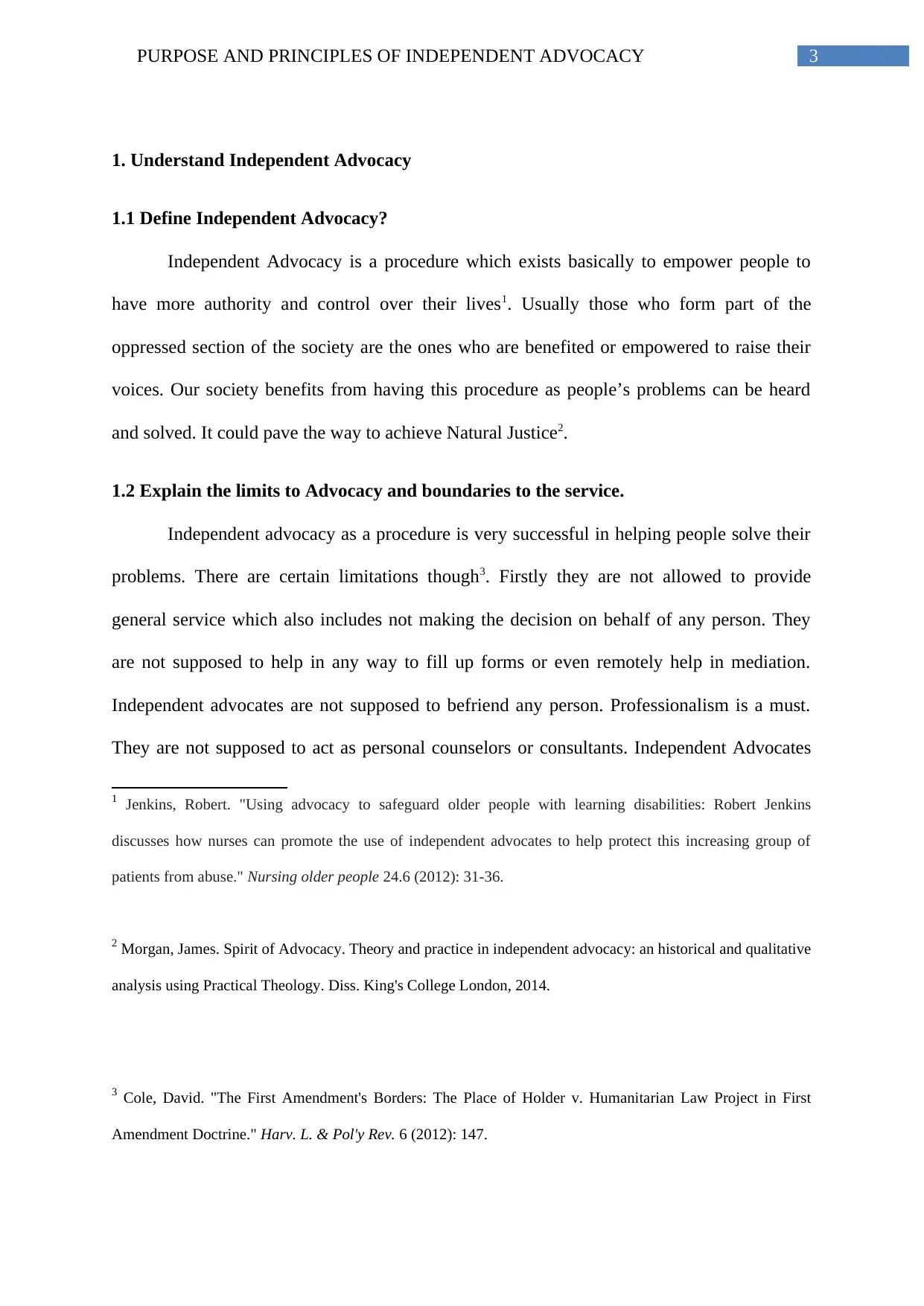
3PURPOSE AND PRINCIPLES OF INDEPENDENT ADVOCACY
1. Understand Independent Advocacy
1.1 Define Independent Advocacy?
Independent Advocacy is a procedure which exists basically to empower people to
have more authority and control over their lives1. Usually those who form part of the
oppressed section of the society are the ones who are benefited or empowered to raise their
voices. Our society benefits from having this procedure as people’s problems can be heard
and solved. It could pave the way to achieve Natural Justice2.
1.2 Explain the limits to Advocacy and boundaries to the service.
Independent advocacy as a procedure is very successful in helping people solve their
problems. There are certain limitations though3. Firstly they are not allowed to provide
general service which also includes not making the decision on behalf of any person. They
are not supposed to help in any way to fill up forms or even remotely help in mediation.
Independent advocates are not supposed to befriend any person. Professionalism is a must.
They are not supposed to act as personal counselors or consultants. Independent Advocates
1 Jenkins, Robert. "Using advocacy to safeguard older people with learning disabilities: Robert Jenkins
discusses how nurses can promote the use of independent advocates to help protect this increasing group of
patients from abuse." Nursing older people 24.6 (2012): 31-36.
2 Morgan, James. Spirit of Advocacy. Theory and practice in independent advocacy: an historical and qualitative
analysis using Practical Theology. Diss. King's College London, 2014.
3 Cole, David. "The First Amendment's Borders: The Place of Holder v. Humanitarian Law Project in First
Amendment Doctrine." Harv. L. & Pol'y Rev. 6 (2012): 147.
1. Understand Independent Advocacy
1.1 Define Independent Advocacy?
Independent Advocacy is a procedure which exists basically to empower people to
have more authority and control over their lives1. Usually those who form part of the
oppressed section of the society are the ones who are benefited or empowered to raise their
voices. Our society benefits from having this procedure as people’s problems can be heard
and solved. It could pave the way to achieve Natural Justice2.
1.2 Explain the limits to Advocacy and boundaries to the service.
Independent advocacy as a procedure is very successful in helping people solve their
problems. There are certain limitations though3. Firstly they are not allowed to provide
general service which also includes not making the decision on behalf of any person. They
are not supposed to help in any way to fill up forms or even remotely help in mediation.
Independent advocates are not supposed to befriend any person. Professionalism is a must.
They are not supposed to act as personal counselors or consultants. Independent Advocates
1 Jenkins, Robert. "Using advocacy to safeguard older people with learning disabilities: Robert Jenkins
discusses how nurses can promote the use of independent advocates to help protect this increasing group of
patients from abuse." Nursing older people 24.6 (2012): 31-36.
2 Morgan, James. Spirit of Advocacy. Theory and practice in independent advocacy: an historical and qualitative
analysis using Practical Theology. Diss. King's College London, 2014.
3 Cole, David. "The First Amendment's Borders: The Place of Holder v. Humanitarian Law Project in First
Amendment Doctrine." Harv. L. & Pol'y Rev. 6 (2012): 147.
Paraphrase This Document
Need a fresh take? Get an instant paraphrase of this document with our AI Paraphraser
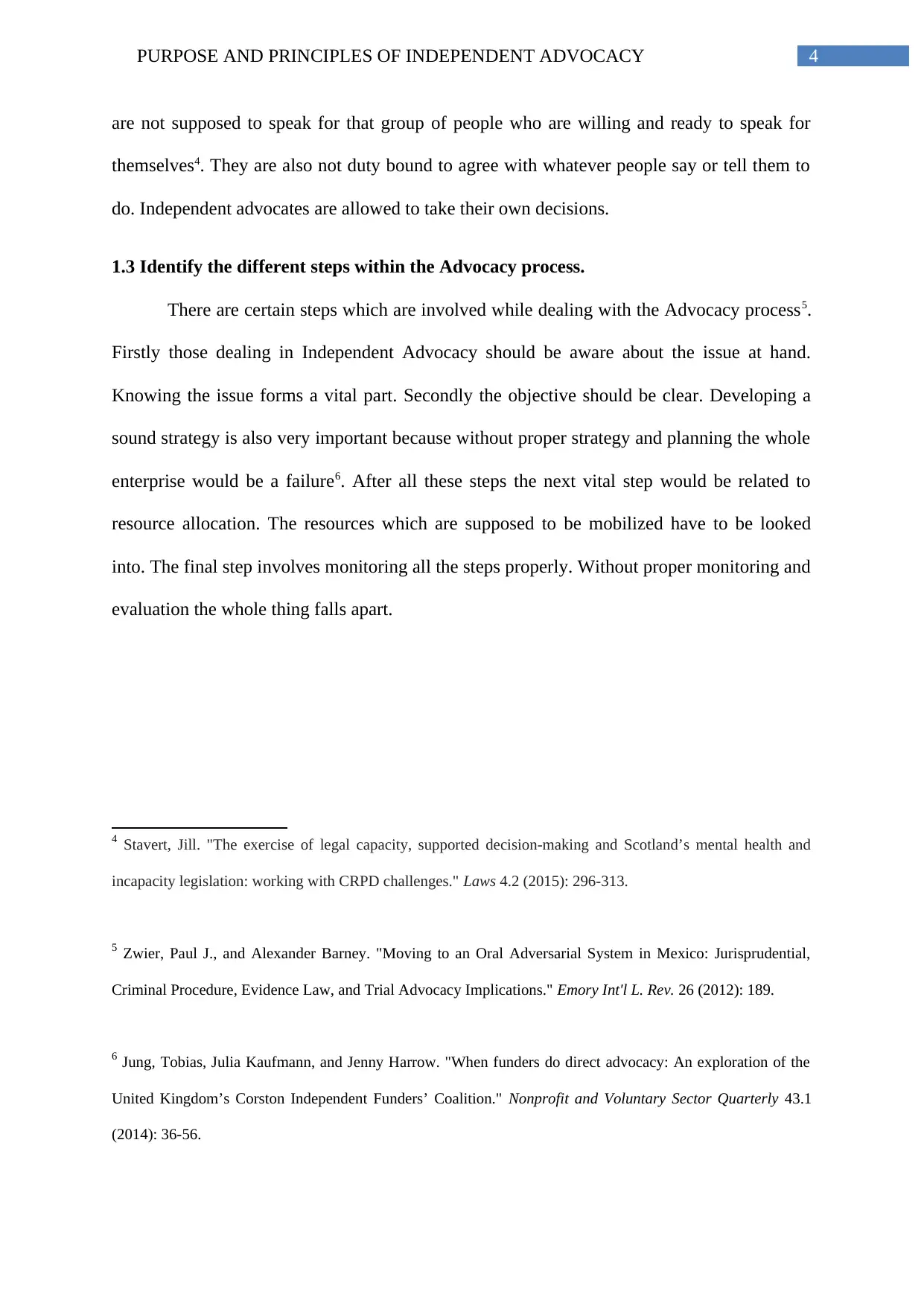
4PURPOSE AND PRINCIPLES OF INDEPENDENT ADVOCACY
are not supposed to speak for that group of people who are willing and ready to speak for
themselves4. They are also not duty bound to agree with whatever people say or tell them to
do. Independent advocates are allowed to take their own decisions.
1.3 Identify the different steps within the Advocacy process.
There are certain steps which are involved while dealing with the Advocacy process5.
Firstly those dealing in Independent Advocacy should be aware about the issue at hand.
Knowing the issue forms a vital part. Secondly the objective should be clear. Developing a
sound strategy is also very important because without proper strategy and planning the whole
enterprise would be a failure6. After all these steps the next vital step would be related to
resource allocation. The resources which are supposed to be mobilized have to be looked
into. The final step involves monitoring all the steps properly. Without proper monitoring and
evaluation the whole thing falls apart.
4 Stavert, Jill. "The exercise of legal capacity, supported decision-making and Scotland’s mental health and
incapacity legislation: working with CRPD challenges." Laws 4.2 (2015): 296-313.
5 Zwier, Paul J., and Alexander Barney. "Moving to an Oral Adversarial System in Mexico: Jurisprudential,
Criminal Procedure, Evidence Law, and Trial Advocacy Implications." Emory Int'l L. Rev. 26 (2012): 189.
6 Jung, Tobias, Julia Kaufmann, and Jenny Harrow. "When funders do direct advocacy: An exploration of the
United Kingdom’s Corston Independent Funders’ Coalition." Nonprofit and Voluntary Sector Quarterly 43.1
(2014): 36-56.
are not supposed to speak for that group of people who are willing and ready to speak for
themselves4. They are also not duty bound to agree with whatever people say or tell them to
do. Independent advocates are allowed to take their own decisions.
1.3 Identify the different steps within the Advocacy process.
There are certain steps which are involved while dealing with the Advocacy process5.
Firstly those dealing in Independent Advocacy should be aware about the issue at hand.
Knowing the issue forms a vital part. Secondly the objective should be clear. Developing a
sound strategy is also very important because without proper strategy and planning the whole
enterprise would be a failure6. After all these steps the next vital step would be related to
resource allocation. The resources which are supposed to be mobilized have to be looked
into. The final step involves monitoring all the steps properly. Without proper monitoring and
evaluation the whole thing falls apart.
4 Stavert, Jill. "The exercise of legal capacity, supported decision-making and Scotland’s mental health and
incapacity legislation: working with CRPD challenges." Laws 4.2 (2015): 296-313.
5 Zwier, Paul J., and Alexander Barney. "Moving to an Oral Adversarial System in Mexico: Jurisprudential,
Criminal Procedure, Evidence Law, and Trial Advocacy Implications." Emory Int'l L. Rev. 26 (2012): 189.
6 Jung, Tobias, Julia Kaufmann, and Jenny Harrow. "When funders do direct advocacy: An exploration of the
United Kingdom’s Corston Independent Funders’ Coalition." Nonprofit and Voluntary Sector Quarterly 43.1
(2014): 36-56.
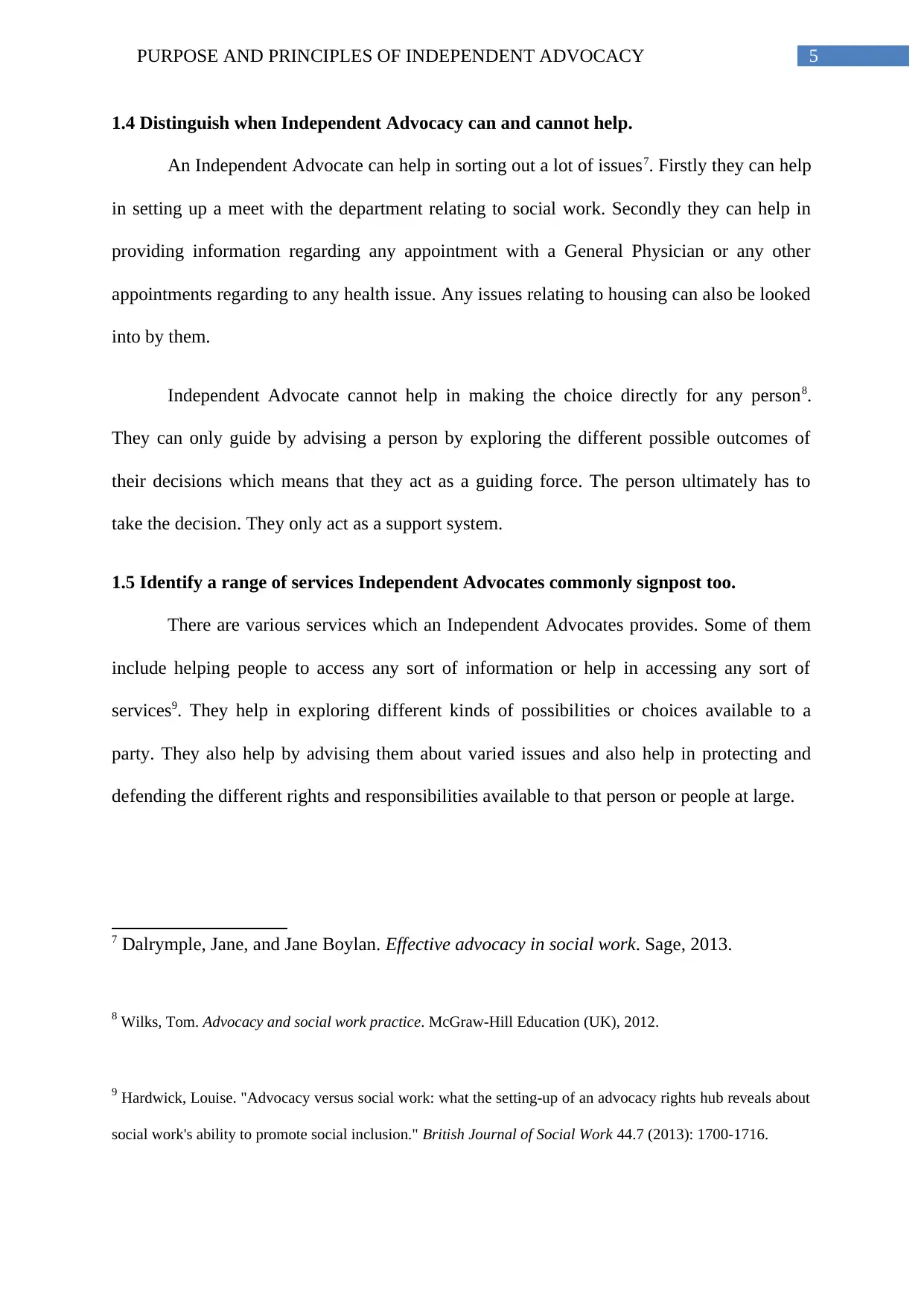
5PURPOSE AND PRINCIPLES OF INDEPENDENT ADVOCACY
1.4 Distinguish when Independent Advocacy can and cannot help.
An Independent Advocate can help in sorting out a lot of issues7. Firstly they can help
in setting up a meet with the department relating to social work. Secondly they can help in
providing information regarding any appointment with a General Physician or any other
appointments regarding to any health issue. Any issues relating to housing can also be looked
into by them.
Independent Advocate cannot help in making the choice directly for any person8.
They can only guide by advising a person by exploring the different possible outcomes of
their decisions which means that they act as a guiding force. The person ultimately has to
take the decision. They only act as a support system.
1.5 Identify a range of services Independent Advocates commonly signpost too.
There are various services which an Independent Advocates provides. Some of them
include helping people to access any sort of information or help in accessing any sort of
services9. They help in exploring different kinds of possibilities or choices available to a
party. They also help by advising them about varied issues and also help in protecting and
defending the different rights and responsibilities available to that person or people at large.
7 Dalrymple, Jane, and Jane Boylan. Effective advocacy in social work. Sage, 2013.
8 Wilks, Tom. Advocacy and social work practice. McGraw-Hill Education (UK), 2012.
9 Hardwick, Louise. "Advocacy versus social work: what the setting-up of an advocacy rights hub reveals about
social work's ability to promote social inclusion." British Journal of Social Work 44.7 (2013): 1700-1716.
1.4 Distinguish when Independent Advocacy can and cannot help.
An Independent Advocate can help in sorting out a lot of issues7. Firstly they can help
in setting up a meet with the department relating to social work. Secondly they can help in
providing information regarding any appointment with a General Physician or any other
appointments regarding to any health issue. Any issues relating to housing can also be looked
into by them.
Independent Advocate cannot help in making the choice directly for any person8.
They can only guide by advising a person by exploring the different possible outcomes of
their decisions which means that they act as a guiding force. The person ultimately has to
take the decision. They only act as a support system.
1.5 Identify a range of services Independent Advocates commonly signpost too.
There are various services which an Independent Advocates provides. Some of them
include helping people to access any sort of information or help in accessing any sort of
services9. They help in exploring different kinds of possibilities or choices available to a
party. They also help by advising them about varied issues and also help in protecting and
defending the different rights and responsibilities available to that person or people at large.
7 Dalrymple, Jane, and Jane Boylan. Effective advocacy in social work. Sage, 2013.
8 Wilks, Tom. Advocacy and social work practice. McGraw-Hill Education (UK), 2012.
9 Hardwick, Louise. "Advocacy versus social work: what the setting-up of an advocacy rights hub reveals about
social work's ability to promote social inclusion." British Journal of Social Work 44.7 (2013): 1700-1716.
⊘ This is a preview!⊘
Do you want full access?
Subscribe today to unlock all pages.

Trusted by 1+ million students worldwide
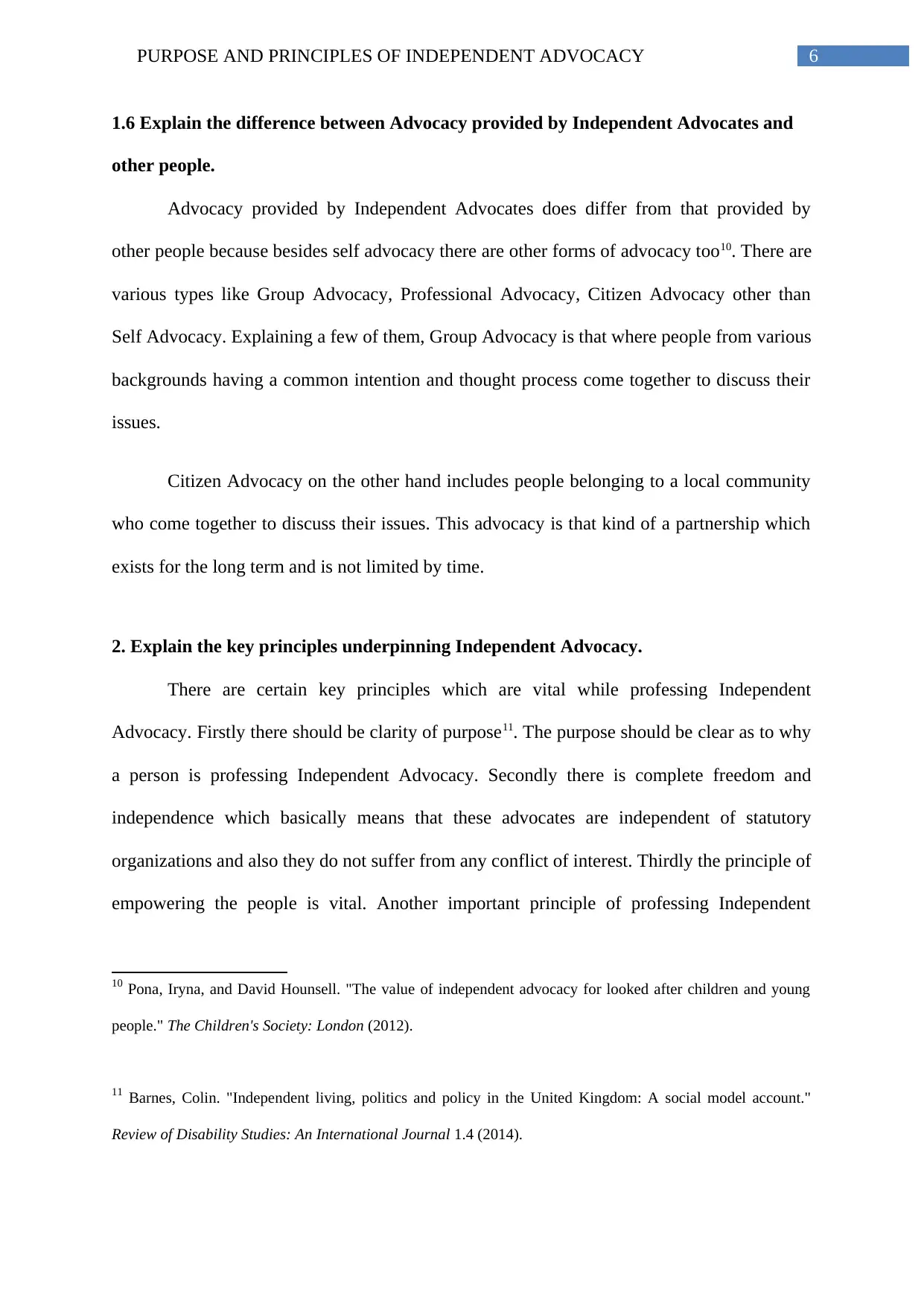
6PURPOSE AND PRINCIPLES OF INDEPENDENT ADVOCACY
1.6 Explain the difference between Advocacy provided by Independent Advocates and
other people.
Advocacy provided by Independent Advocates does differ from that provided by
other people because besides self advocacy there are other forms of advocacy too10. There are
various types like Group Advocacy, Professional Advocacy, Citizen Advocacy other than
Self Advocacy. Explaining a few of them, Group Advocacy is that where people from various
backgrounds having a common intention and thought process come together to discuss their
issues.
Citizen Advocacy on the other hand includes people belonging to a local community
who come together to discuss their issues. This advocacy is that kind of a partnership which
exists for the long term and is not limited by time.
2. Explain the key principles underpinning Independent Advocacy.
There are certain key principles which are vital while professing Independent
Advocacy. Firstly there should be clarity of purpose11. The purpose should be clear as to why
a person is professing Independent Advocacy. Secondly there is complete freedom and
independence which basically means that these advocates are independent of statutory
organizations and also they do not suffer from any conflict of interest. Thirdly the principle of
empowering the people is vital. Another important principle of professing Independent
10 Pona, Iryna, and David Hounsell. "The value of independent advocacy for looked after children and young
people." The Children's Society: London (2012).
11 Barnes, Colin. "Independent living, politics and policy in the United Kingdom: A social model account."
Review of Disability Studies: An International Journal 1.4 (2014).
1.6 Explain the difference between Advocacy provided by Independent Advocates and
other people.
Advocacy provided by Independent Advocates does differ from that provided by
other people because besides self advocacy there are other forms of advocacy too10. There are
various types like Group Advocacy, Professional Advocacy, Citizen Advocacy other than
Self Advocacy. Explaining a few of them, Group Advocacy is that where people from various
backgrounds having a common intention and thought process come together to discuss their
issues.
Citizen Advocacy on the other hand includes people belonging to a local community
who come together to discuss their issues. This advocacy is that kind of a partnership which
exists for the long term and is not limited by time.
2. Explain the key principles underpinning Independent Advocacy.
There are certain key principles which are vital while professing Independent
Advocacy. Firstly there should be clarity of purpose11. The purpose should be clear as to why
a person is professing Independent Advocacy. Secondly there is complete freedom and
independence which basically means that these advocates are independent of statutory
organizations and also they do not suffer from any conflict of interest. Thirdly the principle of
empowering the people is vital. Another important principle of professing Independent
10 Pona, Iryna, and David Hounsell. "The value of independent advocacy for looked after children and young
people." The Children's Society: London (2012).
11 Barnes, Colin. "Independent living, politics and policy in the United Kingdom: A social model account."
Review of Disability Studies: An International Journal 1.4 (2014).
Paraphrase This Document
Need a fresh take? Get an instant paraphrase of this document with our AI Paraphraser
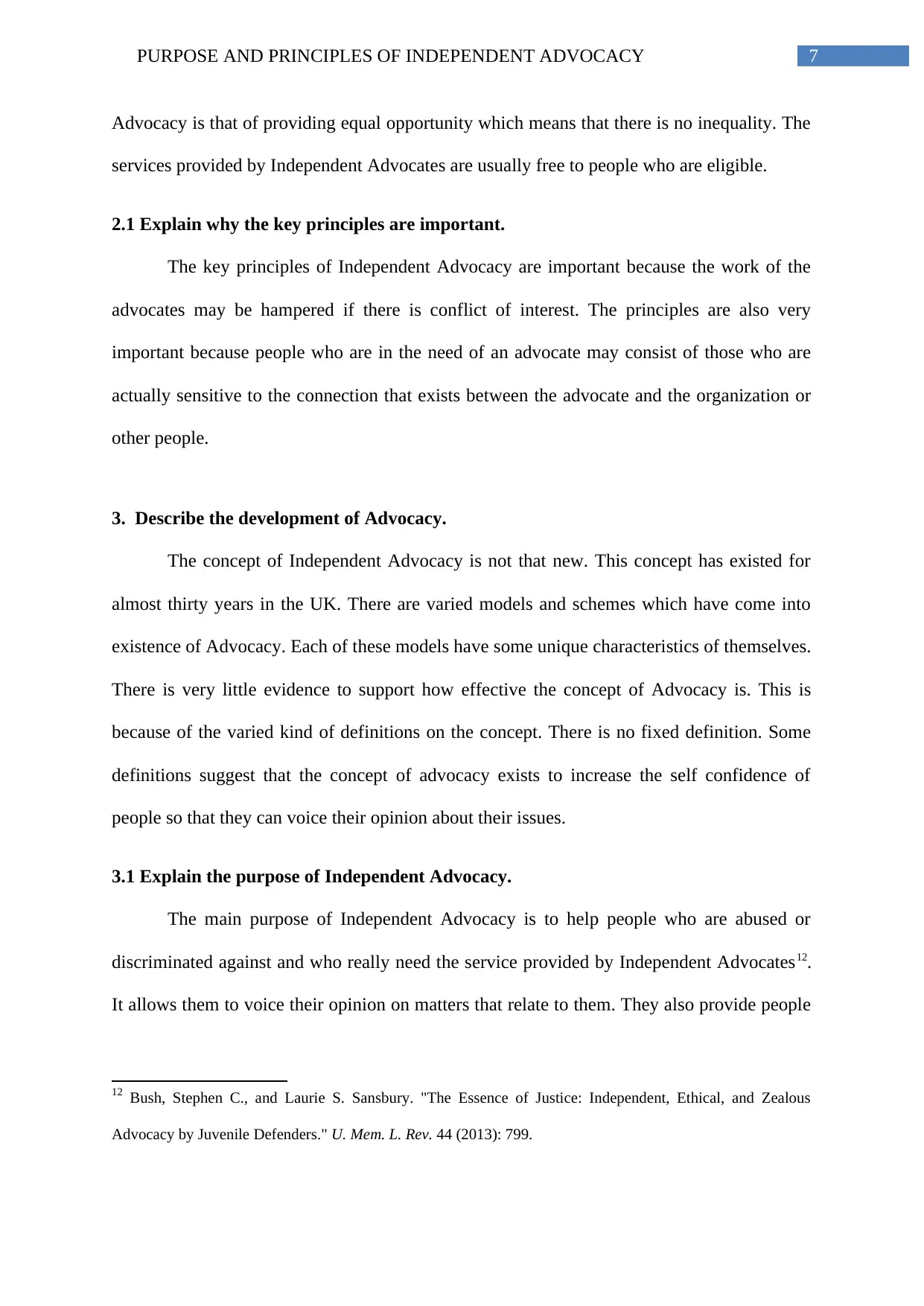
7PURPOSE AND PRINCIPLES OF INDEPENDENT ADVOCACY
Advocacy is that of providing equal opportunity which means that there is no inequality. The
services provided by Independent Advocates are usually free to people who are eligible.
2.1 Explain why the key principles are important.
The key principles of Independent Advocacy are important because the work of the
advocates may be hampered if there is conflict of interest. The principles are also very
important because people who are in the need of an advocate may consist of those who are
actually sensitive to the connection that exists between the advocate and the organization or
other people.
3. Describe the development of Advocacy.
The concept of Independent Advocacy is not that new. This concept has existed for
almost thirty years in the UK. There are varied models and schemes which have come into
existence of Advocacy. Each of these models have some unique characteristics of themselves.
There is very little evidence to support how effective the concept of Advocacy is. This is
because of the varied kind of definitions on the concept. There is no fixed definition. Some
definitions suggest that the concept of advocacy exists to increase the self confidence of
people so that they can voice their opinion about their issues.
3.1 Explain the purpose of Independent Advocacy.
The main purpose of Independent Advocacy is to help people who are abused or
discriminated against and who really need the service provided by Independent Advocates12.
It allows them to voice their opinion on matters that relate to them. They also provide people
12 Bush, Stephen C., and Laurie S. Sansbury. "The Essence of Justice: Independent, Ethical, and Zealous
Advocacy by Juvenile Defenders." U. Mem. L. Rev. 44 (2013): 799.
Advocacy is that of providing equal opportunity which means that there is no inequality. The
services provided by Independent Advocates are usually free to people who are eligible.
2.1 Explain why the key principles are important.
The key principles of Independent Advocacy are important because the work of the
advocates may be hampered if there is conflict of interest. The principles are also very
important because people who are in the need of an advocate may consist of those who are
actually sensitive to the connection that exists between the advocate and the organization or
other people.
3. Describe the development of Advocacy.
The concept of Independent Advocacy is not that new. This concept has existed for
almost thirty years in the UK. There are varied models and schemes which have come into
existence of Advocacy. Each of these models have some unique characteristics of themselves.
There is very little evidence to support how effective the concept of Advocacy is. This is
because of the varied kind of definitions on the concept. There is no fixed definition. Some
definitions suggest that the concept of advocacy exists to increase the self confidence of
people so that they can voice their opinion about their issues.
3.1 Explain the purpose of Independent Advocacy.
The main purpose of Independent Advocacy is to help people who are abused or
discriminated against and who really need the service provided by Independent Advocates12.
It allows them to voice their opinion on matters that relate to them. They also provide people
12 Bush, Stephen C., and Laurie S. Sansbury. "The Essence of Justice: Independent, Ethical, and Zealous
Advocacy by Juvenile Defenders." U. Mem. L. Rev. 44 (2013): 799.
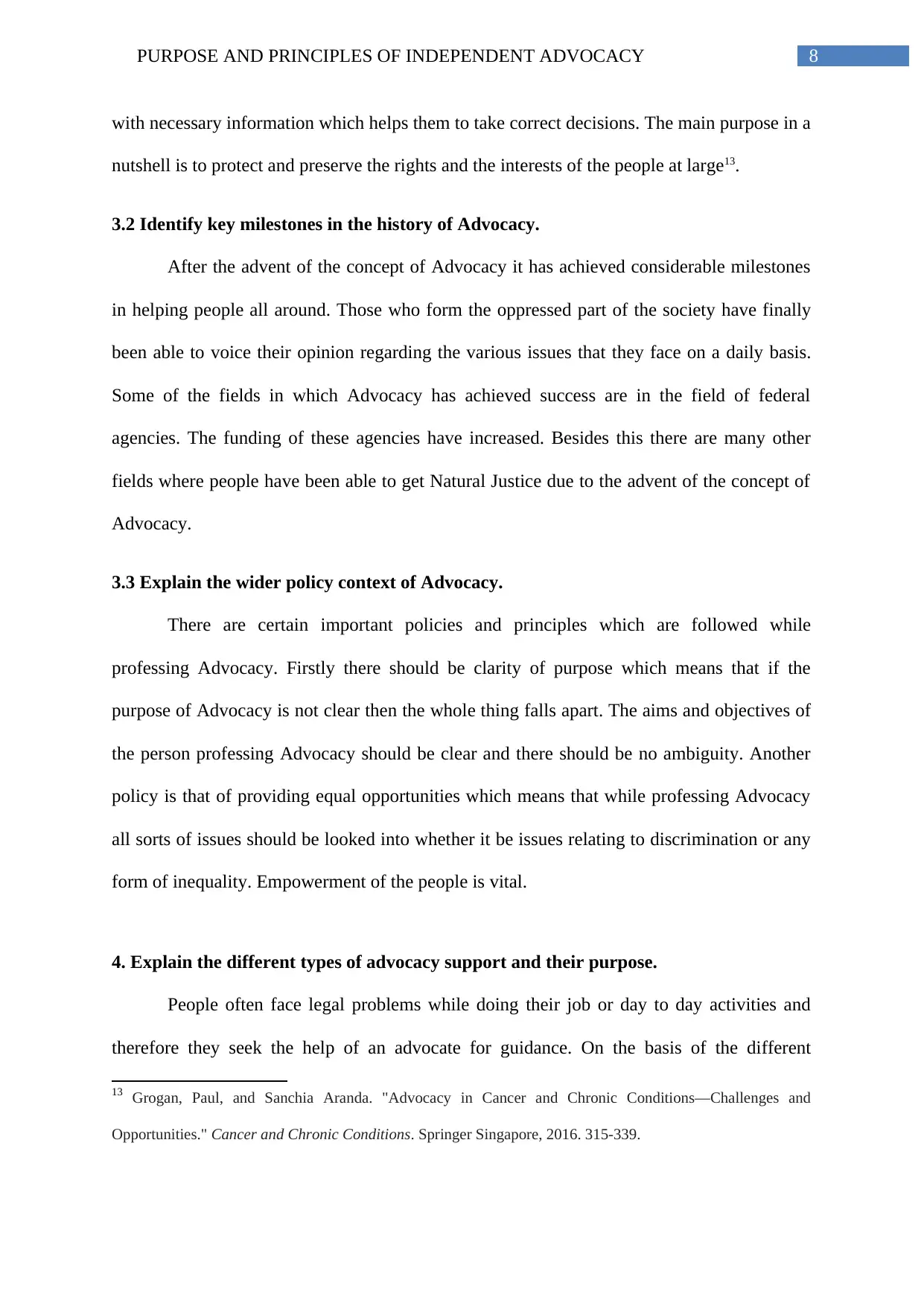
8PURPOSE AND PRINCIPLES OF INDEPENDENT ADVOCACY
with necessary information which helps them to take correct decisions. The main purpose in a
nutshell is to protect and preserve the rights and the interests of the people at large13.
3.2 Identify key milestones in the history of Advocacy.
After the advent of the concept of Advocacy it has achieved considerable milestones
in helping people all around. Those who form the oppressed part of the society have finally
been able to voice their opinion regarding the various issues that they face on a daily basis.
Some of the fields in which Advocacy has achieved success are in the field of federal
agencies. The funding of these agencies have increased. Besides this there are many other
fields where people have been able to get Natural Justice due to the advent of the concept of
Advocacy.
3.3 Explain the wider policy context of Advocacy.
There are certain important policies and principles which are followed while
professing Advocacy. Firstly there should be clarity of purpose which means that if the
purpose of Advocacy is not clear then the whole thing falls apart. The aims and objectives of
the person professing Advocacy should be clear and there should be no ambiguity. Another
policy is that of providing equal opportunities which means that while professing Advocacy
all sorts of issues should be looked into whether it be issues relating to discrimination or any
form of inequality. Empowerment of the people is vital.
4. Explain the different types of advocacy support and their purpose.
People often face legal problems while doing their job or day to day activities and
therefore they seek the help of an advocate for guidance. On the basis of the different
13 Grogan, Paul, and Sanchia Aranda. "Advocacy in Cancer and Chronic Conditions—Challenges and
Opportunities." Cancer and Chronic Conditions. Springer Singapore, 2016. 315-339.
with necessary information which helps them to take correct decisions. The main purpose in a
nutshell is to protect and preserve the rights and the interests of the people at large13.
3.2 Identify key milestones in the history of Advocacy.
After the advent of the concept of Advocacy it has achieved considerable milestones
in helping people all around. Those who form the oppressed part of the society have finally
been able to voice their opinion regarding the various issues that they face on a daily basis.
Some of the fields in which Advocacy has achieved success are in the field of federal
agencies. The funding of these agencies have increased. Besides this there are many other
fields where people have been able to get Natural Justice due to the advent of the concept of
Advocacy.
3.3 Explain the wider policy context of Advocacy.
There are certain important policies and principles which are followed while
professing Advocacy. Firstly there should be clarity of purpose which means that if the
purpose of Advocacy is not clear then the whole thing falls apart. The aims and objectives of
the person professing Advocacy should be clear and there should be no ambiguity. Another
policy is that of providing equal opportunities which means that while professing Advocacy
all sorts of issues should be looked into whether it be issues relating to discrimination or any
form of inequality. Empowerment of the people is vital.
4. Explain the different types of advocacy support and their purpose.
People often face legal problems while doing their job or day to day activities and
therefore they seek the help of an advocate for guidance. On the basis of the different
13 Grogan, Paul, and Sanchia Aranda. "Advocacy in Cancer and Chronic Conditions—Challenges and
Opportunities." Cancer and Chronic Conditions. Springer Singapore, 2016. 315-339.
⊘ This is a preview!⊘
Do you want full access?
Subscribe today to unlock all pages.

Trusted by 1+ million students worldwide
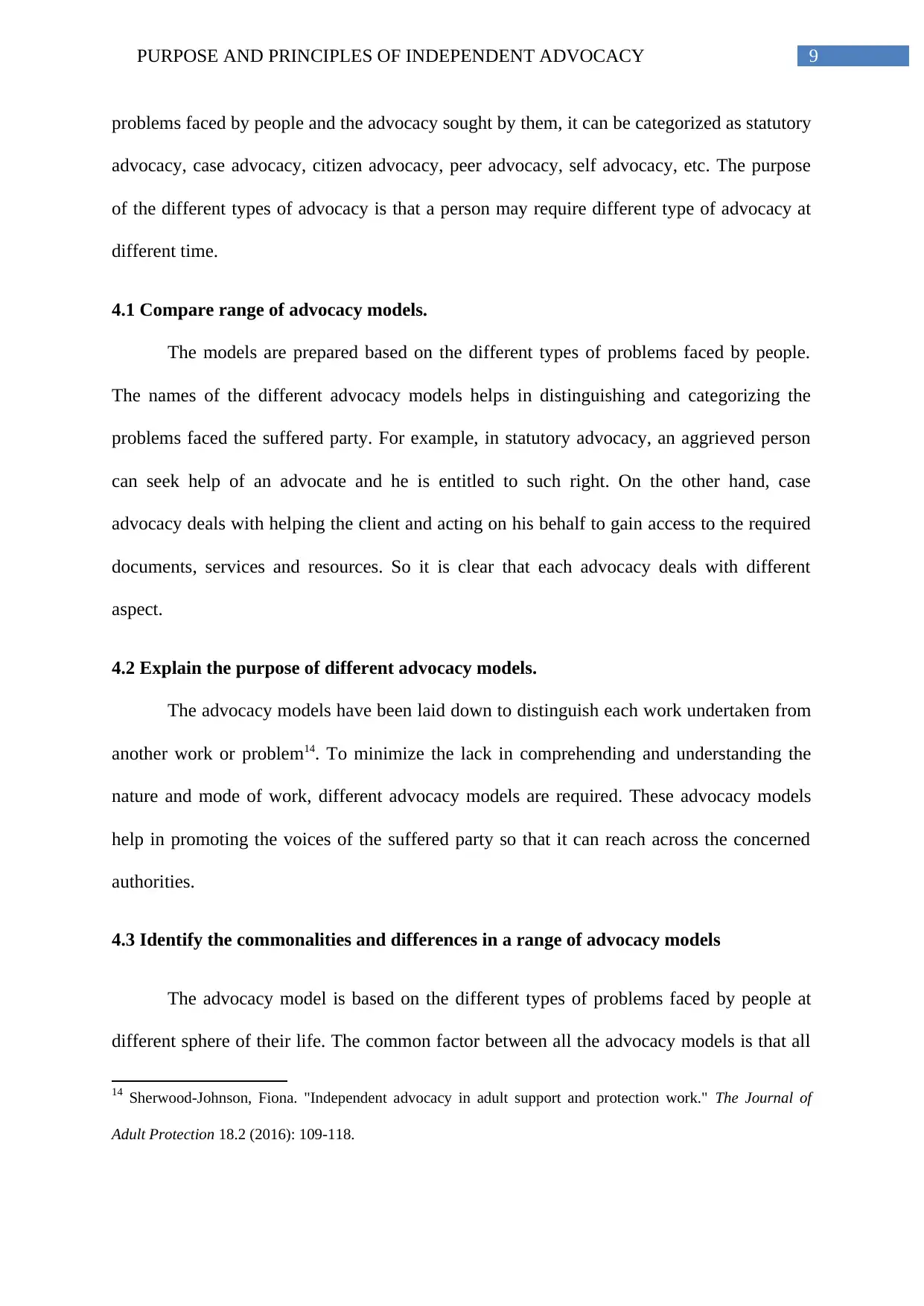
9PURPOSE AND PRINCIPLES OF INDEPENDENT ADVOCACY
problems faced by people and the advocacy sought by them, it can be categorized as statutory
advocacy, case advocacy, citizen advocacy, peer advocacy, self advocacy, etc. The purpose
of the different types of advocacy is that a person may require different type of advocacy at
different time.
4.1 Compare range of advocacy models.
The models are prepared based on the different types of problems faced by people.
The names of the different advocacy models helps in distinguishing and categorizing the
problems faced the suffered party. For example, in statutory advocacy, an aggrieved person
can seek help of an advocate and he is entitled to such right. On the other hand, case
advocacy deals with helping the client and acting on his behalf to gain access to the required
documents, services and resources. So it is clear that each advocacy deals with different
aspect.
4.2 Explain the purpose of different advocacy models.
The advocacy models have been laid down to distinguish each work undertaken from
another work or problem14. To minimize the lack in comprehending and understanding the
nature and mode of work, different advocacy models are required. These advocacy models
help in promoting the voices of the suffered party so that it can reach across the concerned
authorities.
4.3 Identify the commonalities and differences in a range of advocacy models
The advocacy model is based on the different types of problems faced by people at
different sphere of their life. The common factor between all the advocacy models is that all
14 Sherwood-Johnson, Fiona. "Independent advocacy in adult support and protection work." The Journal of
Adult Protection 18.2 (2016): 109-118.
problems faced by people and the advocacy sought by them, it can be categorized as statutory
advocacy, case advocacy, citizen advocacy, peer advocacy, self advocacy, etc. The purpose
of the different types of advocacy is that a person may require different type of advocacy at
different time.
4.1 Compare range of advocacy models.
The models are prepared based on the different types of problems faced by people.
The names of the different advocacy models helps in distinguishing and categorizing the
problems faced the suffered party. For example, in statutory advocacy, an aggrieved person
can seek help of an advocate and he is entitled to such right. On the other hand, case
advocacy deals with helping the client and acting on his behalf to gain access to the required
documents, services and resources. So it is clear that each advocacy deals with different
aspect.
4.2 Explain the purpose of different advocacy models.
The advocacy models have been laid down to distinguish each work undertaken from
another work or problem14. To minimize the lack in comprehending and understanding the
nature and mode of work, different advocacy models are required. These advocacy models
help in promoting the voices of the suffered party so that it can reach across the concerned
authorities.
4.3 Identify the commonalities and differences in a range of advocacy models
The advocacy model is based on the different types of problems faced by people at
different sphere of their life. The common factor between all the advocacy models is that all
14 Sherwood-Johnson, Fiona. "Independent advocacy in adult support and protection work." The Journal of
Adult Protection 18.2 (2016): 109-118.
Paraphrase This Document
Need a fresh take? Get an instant paraphrase of this document with our AI Paraphraser
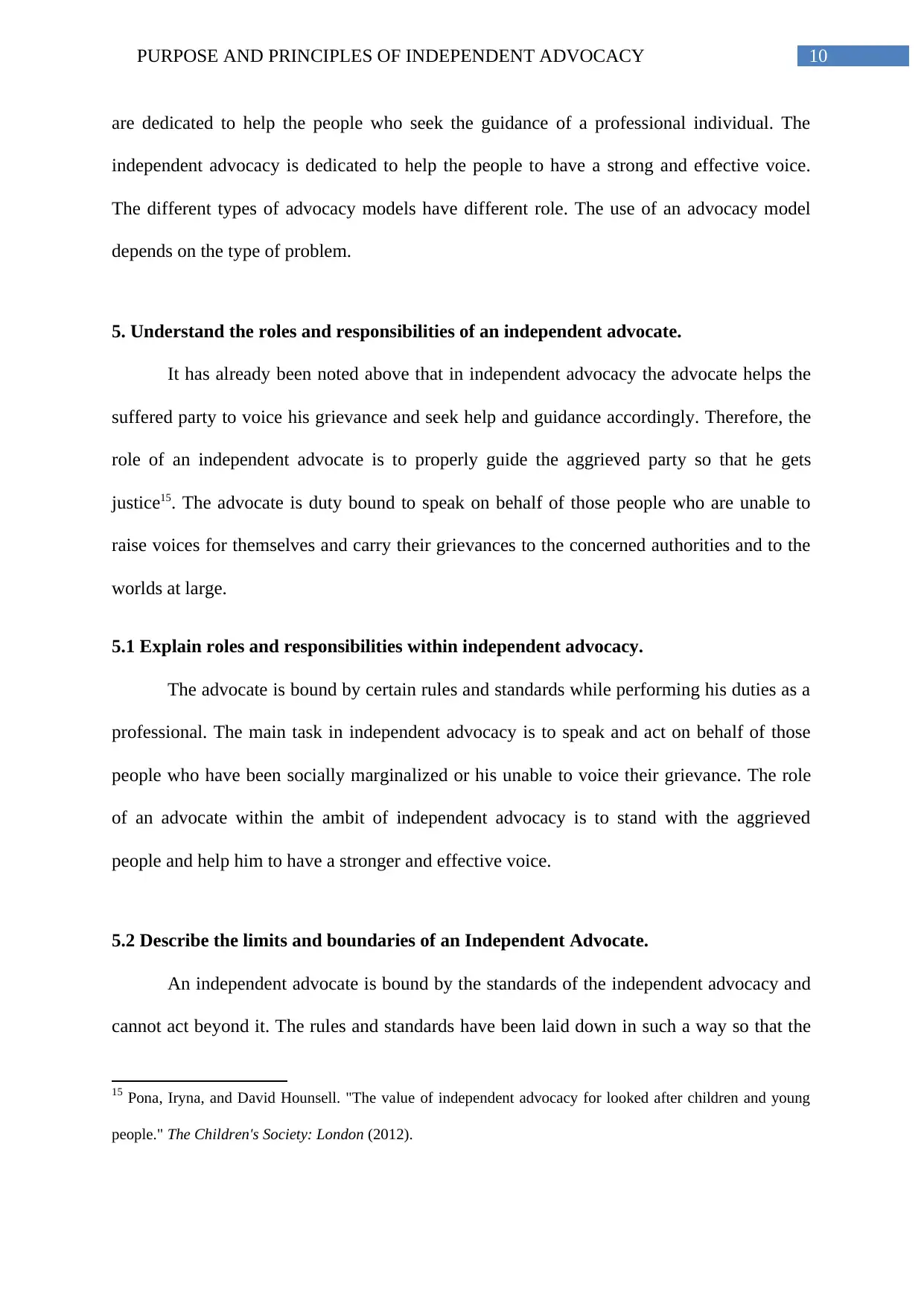
10PURPOSE AND PRINCIPLES OF INDEPENDENT ADVOCACY
are dedicated to help the people who seek the guidance of a professional individual. The
independent advocacy is dedicated to help the people to have a strong and effective voice.
The different types of advocacy models have different role. The use of an advocacy model
depends on the type of problem.
5. Understand the roles and responsibilities of an independent advocate.
It has already been noted above that in independent advocacy the advocate helps the
suffered party to voice his grievance and seek help and guidance accordingly. Therefore, the
role of an independent advocate is to properly guide the aggrieved party so that he gets
justice15. The advocate is duty bound to speak on behalf of those people who are unable to
raise voices for themselves and carry their grievances to the concerned authorities and to the
worlds at large.
5.1 Explain roles and responsibilities within independent advocacy.
The advocate is bound by certain rules and standards while performing his duties as a
professional. The main task in independent advocacy is to speak and act on behalf of those
people who have been socially marginalized or his unable to voice their grievance. The role
of an advocate within the ambit of independent advocacy is to stand with the aggrieved
people and help him to have a stronger and effective voice.
5.2 Describe the limits and boundaries of an Independent Advocate.
An independent advocate is bound by the standards of the independent advocacy and
cannot act beyond it. The rules and standards have been laid down in such a way so that the
15 Pona, Iryna, and David Hounsell. "The value of independent advocacy for looked after children and young
people." The Children's Society: London (2012).
are dedicated to help the people who seek the guidance of a professional individual. The
independent advocacy is dedicated to help the people to have a strong and effective voice.
The different types of advocacy models have different role. The use of an advocacy model
depends on the type of problem.
5. Understand the roles and responsibilities of an independent advocate.
It has already been noted above that in independent advocacy the advocate helps the
suffered party to voice his grievance and seek help and guidance accordingly. Therefore, the
role of an independent advocate is to properly guide the aggrieved party so that he gets
justice15. The advocate is duty bound to speak on behalf of those people who are unable to
raise voices for themselves and carry their grievances to the concerned authorities and to the
worlds at large.
5.1 Explain roles and responsibilities within independent advocacy.
The advocate is bound by certain rules and standards while performing his duties as a
professional. The main task in independent advocacy is to speak and act on behalf of those
people who have been socially marginalized or his unable to voice their grievance. The role
of an advocate within the ambit of independent advocacy is to stand with the aggrieved
people and help him to have a stronger and effective voice.
5.2 Describe the limits and boundaries of an Independent Advocate.
An independent advocate is bound by the standards of the independent advocacy and
cannot act beyond it. The rules and standards have been laid down in such a way so that the
15 Pona, Iryna, and David Hounsell. "The value of independent advocacy for looked after children and young
people." The Children's Society: London (2012).
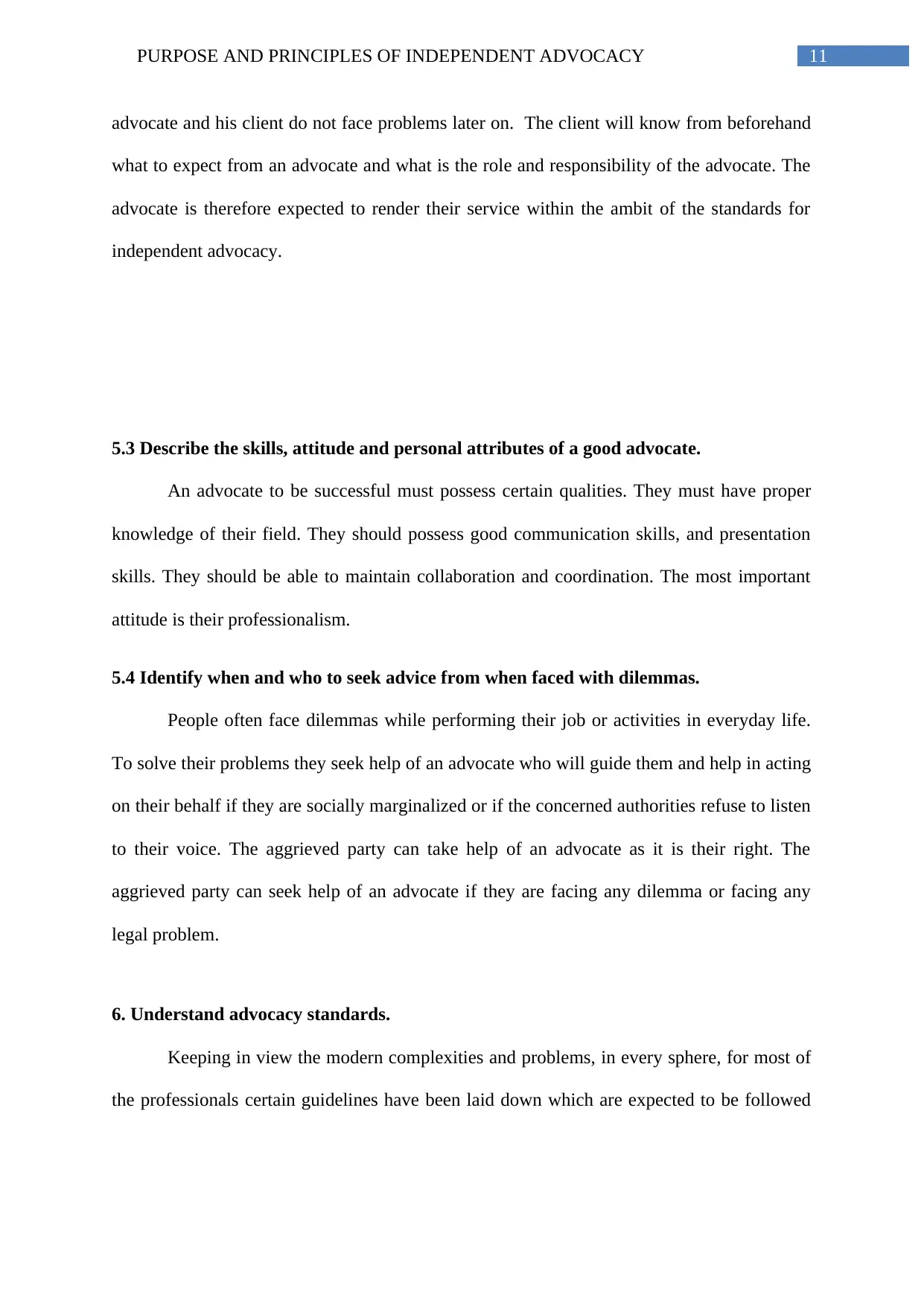
11PURPOSE AND PRINCIPLES OF INDEPENDENT ADVOCACY
advocate and his client do not face problems later on. The client will know from beforehand
what to expect from an advocate and what is the role and responsibility of the advocate. The
advocate is therefore expected to render their service within the ambit of the standards for
independent advocacy.
5.3 Describe the skills, attitude and personal attributes of a good advocate.
An advocate to be successful must possess certain qualities. They must have proper
knowledge of their field. They should possess good communication skills, and presentation
skills. They should be able to maintain collaboration and coordination. The most important
attitude is their professionalism.
5.4 Identify when and who to seek advice from when faced with dilemmas.
People often face dilemmas while performing their job or activities in everyday life.
To solve their problems they seek help of an advocate who will guide them and help in acting
on their behalf if they are socially marginalized or if the concerned authorities refuse to listen
to their voice. The aggrieved party can take help of an advocate as it is their right. The
aggrieved party can seek help of an advocate if they are facing any dilemma or facing any
legal problem.
6. Understand advocacy standards.
Keeping in view the modern complexities and problems, in every sphere, for most of
the professionals certain guidelines have been laid down which are expected to be followed
advocate and his client do not face problems later on. The client will know from beforehand
what to expect from an advocate and what is the role and responsibility of the advocate. The
advocate is therefore expected to render their service within the ambit of the standards for
independent advocacy.
5.3 Describe the skills, attitude and personal attributes of a good advocate.
An advocate to be successful must possess certain qualities. They must have proper
knowledge of their field. They should possess good communication skills, and presentation
skills. They should be able to maintain collaboration and coordination. The most important
attitude is their professionalism.
5.4 Identify when and who to seek advice from when faced with dilemmas.
People often face dilemmas while performing their job or activities in everyday life.
To solve their problems they seek help of an advocate who will guide them and help in acting
on their behalf if they are socially marginalized or if the concerned authorities refuse to listen
to their voice. The aggrieved party can take help of an advocate as it is their right. The
aggrieved party can seek help of an advocate if they are facing any dilemma or facing any
legal problem.
6. Understand advocacy standards.
Keeping in view the modern complexities and problems, in every sphere, for most of
the professionals certain guidelines have been laid down which are expected to be followed
⊘ This is a preview!⊘
Do you want full access?
Subscribe today to unlock all pages.

Trusted by 1+ million students worldwide
1 out of 15
Related Documents
Your All-in-One AI-Powered Toolkit for Academic Success.
+13062052269
info@desklib.com
Available 24*7 on WhatsApp / Email
![[object Object]](/_next/static/media/star-bottom.7253800d.svg)
Unlock your academic potential
Copyright © 2020–2025 A2Z Services. All Rights Reserved. Developed and managed by ZUCOL.




